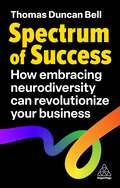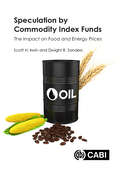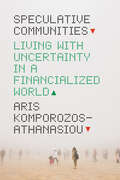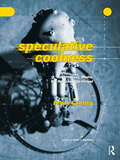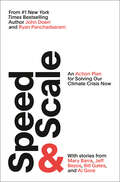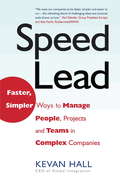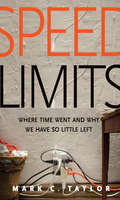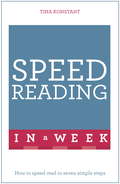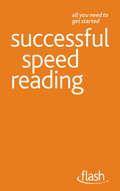- Table View
- List View
Spectrum of Success: How Embracing Neurodiversity Can Revolutionize Your Business
by Thomas Duncan BellUnlock the full potential of neurodiverse people and create a more inclusive, supportive and adaptive business with Spectrum of Success.20% of the global population is neurodivergent, but the world isn't built for them. Their incredible talent becomes wasted when they don't have the opportunity to succeed. Spectrum of Success uncovers how we can create a more accessible work culture that champions neurodiversity and promotes allyship and collaboration.Through fascinating research and inspiring interviews with neurodiverse business leaders, mental health expert Thomas Duncan Bell uncovers how we can support and champion neurodiversity at work and beyond. Drawing upon his own experiences with ADHD and bipolar disorder, the book also offers an enlightening insight into how neurodiverse individuals can thrive in the modern world.
Spectrum-Aware Mobile Computing: Convergence of Cloud Computing and Cognitive Networking (Signals and Communication Technology)
by R. N. Uma Seyed Eman Mahmoodi Koduvayur SubbalakshmiThis book presents solutions to the problems arising in two trends in mobile computing and their intersection: increased mobile traffic driven mainly by sophisticated smart phone applications; and the issue of user demand for lighter phones, which cause more battery power constrained handhelds to offload computations to resource intensive clouds (the second trend exacerbating the bandwidth crunch often experienced over wireless networks). The authors posit a new solution called spectrum aware cognitive mobile computing, which uses dynamic spectrum access and management concepts from wireless networking to offer overall optimized computation offloading and scheduling solutions that achieve optimal trade-offs between the mobile device and wireless resources. They show how in order to allow these competing goals to meet in the middle, and to meet the promise of 5G mobile computing, it is essential to consider mobile offloading holistically, from end to end and use the power of multi-radio access technologies that have been recently developed. Technologies covered in this book have applications to mobile computing, edge computing, fog computing, vehicular communications, mobile healthcare, mobile application developments such as augmented reality, and virtual reality.
Speculate This!
by Uncertain CommonsA short, timely manifesto critiquing predatory modes of financial speculation that seek to minimize uncertainty and risk, while advocating speculative practices that embrace uncertainty, spur radical change, and enable alternative futures.
Speculation by Commodity Index Funds: The Impact on Food and Energy Prices
by Professor Scott H. Irwin Professor Dwight R. SandersCommodity futures prices exploded in 2007-2008 and concerns about a new type of speculative participant in commodity futures markets began to emerge. The main argument was that unprecedented buying pressure from new "commodity index" investors created massive bubbles that resulted in prices substantially exceeding fundamental value. At the time, it was not uncommon to link concerns about speculation and high prices to world hunger, food crises, and civil unrest. Naturally, this outcry resulted in numerous regulatory proposals to restrict speculation in commodity futures markets. At the core, these assertions raised major economic questions about the efficiency of price discovery in commodity futures markets. Moreover, these so-called remedies did not come without a potential cost. Burdensome regulations would increase compliance and risk sharing costs across the global food system, lowering prices for producers and increasing costs to consumers. This book presents important research on the impact of index investment on commodity futures prices that the authors conducted over the last fifteen years. The eleven articles presented in the book follow the timeline of our involvement in the world-wide debate about index funds as it evolved after 2007. We also include an introductory chapter, new author forewords for each article chapter, and a lessons learned chapter to round out the book. Policy-makers, researchers, and market participants will find the book not only functions as useful documentation of the debate; but, also as a natural starting point when high commodity prices inevitably create the next speculation backlash.
Speculation, Trading, and Bubbles
by Joseph E. Stiglitz Patrick Bolton Kenneth J. Arrow Sanford J. Grossman José A. ScheinkmanThe history of financial markets is full of moments in which asset prices inflate far beyond their intrinsic value. These events are commonly called bubbles, and in this book, José A. Scheinkman and other top economists offer new explanations for this phenomenon.Scheinkman discusses some stylized facts concerning bubbles, such as high trading volume and the coincidence between bubbles' implosion and increases in supply, and he develops a model for bubbles based on differences in beliefs among investors that explains these observations. Sandy Grossman and Patrick Bolton offer commentaries on Scheinkman's work, investigating factors that contribute to bubbles, such as excessive leverage, overconfidence, mania, and panic in speculative markets. Kenneth J. Arrow and Joseph E. Stiglitz add introductory material contextualizing Scheinkman's findings.
Speculation, Trading, and Bubbles (Kenneth J. Arrow Lecture Series)
by José A. ScheinkmanAs long as there have been financial markets, there have been bubbles—those moments in which asset prices inflate far beyond their intrinsic value, often with ruinous results. Yet economists are slow to agree on the underlying forces behind these events. In this book José A. Scheinkman offers new insight into the mystery of bubbles. Noting some general characteristics of bubbles—such as the rise in trading volume and the coincidence between increases in supply and bubble implosions—Scheinkman offers a model, based on differences in beliefs among investors, that explains these observations. Other top economists also offer their own thoughts on the issue: Sanford J. Grossman and Patrick Bolton expand on Scheinkman's discussion by looking at factors that contribute to bubbles—such as excessive leverage, overconfidence, mania, and panic in speculative markets—and Kenneth J. Arrow and Joseph E. Stiglitz contextualize Scheinkman's findings.
Speculative Communities: Living with Uncertainty in a Financialized World
by Aris Komporozos-AthanasiouSpeculative Communities investigates the financial world’s influence on the social imagination, unraveling its radical effects on our personal and political lives. In Speculative Communities, Aris Komporozos-Athanasiou examines the ways that speculation has moved beyond financial markets to shape fundamental aspects of our social and political lives. As ordinary people make exceptional decisions, such as the American election of a populist demagogue or the British vote to leave the European Union, they are moving from time-honored and -tested practices of governance, toward the speculative promise of a new, more uncertain future. This book shows how even our methods of building community have shifted to the speculative realm as social media platforms enable and amplify our volatile wagers. For Komporozos-Athanasiou, “to speculate” means increasingly “to connect,” to endorse the unknown pre-emptively, and often daringly, as a means of social survival. Grappling with the question of how more uncertainty can lead to its full-throated embrace rather than dissent, Speculative Communities shows how finance has become the model for society writ large. As Komporozos-Athanasiou argues, virtual marketplaces, new social media, and dating apps bring finance’s opaque infrastructures into the most intimate realms of our lives, leading to a new type of speculative imagination across economy, culture, and society.
Speculative Communities: Living with Uncertainty in a Financialized World
by Aris Komporozos-AthanasiouSpeculative Communities investigates the financial world’s influence on the social imagination, unraveling its radical effects on our personal and political lives. In Speculative Communities, Aris Komporozos-Athanasiou examines the ways that speculation has moved beyond financial markets to shape fundamental aspects of our social and political lives. As ordinary people make exceptional decisions, such as the American election of a populist demagogue or the British vote to leave the European Union, they are moving from time-honored and -tested practices of governance, toward the speculative promise of a new, more uncertain future. This book shows how even our methods of building community have shifted to the speculative realm as social media platforms enable and amplify our volatile wagers. For Komporozos-Athanasiou, “to speculate” means increasingly “to connect,” to endorse the unknown pre-emptively, and often daringly, as a means of social survival. Grappling with the question of how more uncertainty can lead to its full-throated embrace rather than dissent, Speculative Communities shows how finance has become the model for society writ large. As Komporozos-Athanasiou argues, virtual marketplaces, new social media, and dating apps bring finance’s opaque infrastructures into the most intimate realms of our lives, leading to a new type of speculative imagination across economy, culture, and society.
Speculative Communities: Living with Uncertainty in a Financialized World
by Aris Komporozos-AthanasiouSpeculative Communities investigates the financial world’s influence on the social imagination, unraveling its radical effects on our personal and political lives. In Speculative Communities, Aris Komporozos-Athanasiou examines the ways that speculation has moved beyond financial markets to shape fundamental aspects of our social and political lives. As ordinary people make exceptional decisions, such as the American election of a populist demagogue or the British vote to leave the European Union, they are moving from time-honored and -tested practices of governance, toward the speculative promise of a new, more uncertain future. This book shows how even our methods of building community have shifted to the speculative realm as social media platforms enable and amplify our volatile wagers. For Komporozos-Athanasiou, “to speculate” means increasingly “to connect,” to endorse the unknown pre-emptively, and often daringly, as a means of social survival. Grappling with the question of how more uncertainty can lead to its full-throated embrace rather than dissent, Speculative Communities shows how finance has become the model for society writ large. As Komporozos-Athanasiou argues, virtual marketplaces, new social media, and dating apps bring finance’s opaque infrastructures into the most intimate realms of our lives, leading to a new type of speculative imagination across economy, culture, and society.
Speculative Coolness: Architecture, Media, the Real, and the Virtual
by Bryan CantleyCantley’s work offers a unique and critical insight into the emergence of a liminal territory that exists between the real and the virtual that mainstream architecture has yet to exploit. Speculative Coolness surveys and collects a highly experimental architecture/design praxis. This book presents a selected body of his work, showcasing projects which seek to understand and explore the conditions, contexts, and media logics which govern this new territory, and to speculate on the Architecture[s] which it might occupy, and which might occupy it. Featuring both resolved projects and work[s] that are under development, this anthology represents constructs that locate themselves somewhere between architecture and its documentative media. The projects are presented alongside a series of critical essays written by pre-eminent architectural practitioners and theorists. These essays explore the disciplinary, social, and cultural context of the work, serving to underscore the importance of these explorations to the expansion of disciplinary knowledge.
Specworld: Folds, Faults, and Fractures in Embedded Creator Industries
by John Thornton CaldwellJohn Thornton Caldwell’s landmark Specworld demonstrates how twenty-first-century media industries monetize and industrialize creative labor at all levels of production. Through illuminating case studies and rich ethnography of colliding social-media and filmmaking practices, Caldwell takes readers into the world of production workshopping and trade mentoring to show media production as an untidy social construct rather than a unified, stable practice. This messy complex system, he argues, is full of discrete yet interconnected parts that include legacy production companies, marketers and influencers, aspirant online producers, data miners, financiers, talent agencies, and more. Caldwell peels away the layers of these embedded production systems to examine the folds, fault lines, and fractures that underlie a risky, high-pressure, and often exploitative industry. With insights on the ethical and human predicament faced by industry hopefuls and crossover creators seeking professional careers, Caldwell offers new interpretive frames and research methods that allow readers to better see the hidden and multifaceted financial logics and forms of labor embedded in contemporary media production industries.
Speechless: The Erosion of Free Expression in the American Workplace
by Bruce BarryA factory worker is fired because her boss dislikes the political bumper sticker on her car in the parking lot. Another is canned after refusing to display an American flag at his workstation.
Speed & Scale: An Action Plan for Solving Our Climate Crisis Now
by John Doerr#1 bestselling author and acclaimed venture capitalist John Doerr reveals a sweeping action plan to conquer humanity&’s greatest challenge: climate change.In 2006, John Doerr was moved by Al Gore&’s An Inconvenient Truth and a challenge from his teenage daughter: &“Dad, your generation created this problem. You better fix it.&” Since then, Doerr has searched for solutions to this existential problem—as an investor, an advocate, and a philanthropist. Fifteen years later, despite breakthroughs in batteries, electric vehicles, plant-based proteins, and solar and wind power, global warming continues to get worse. Its impact is all around us: droughts, floods, wildfires, the melting of the polar ice caps. Our world is squarely in a climate crisis and on the brink of a climate disaster. Yet despite our state of emergency, climate change has yet to be tackled with the urgency and ambition it demands. More than ever, we need a clear course of action. What if the goal-setting techniques that powered the rise of today's most innovative organizations were brought to bear on humanity's greatest challenge? Fueled by a powerful tool called Objectives and Key Results (OKRs), SPEED & SCALE offers an unprecedented global plan to cut greenhouse gas emissions before it&’s too late. Used by Google, Bono&’s ONE foundation, and thousands of startups the world over, OKRs have scaled ideas into achievements that changed the world. With clear-eyed realism and an engineer&’s precision, Doerr identifies the measurable OKRs we need to reduce emissions across the board and to arrive by 2050 at net zero—the point where we are no longer adding to the heat-trapping carbon in the atmosphere. By turns pragmatic and inspiring, SPEED & SCALE intersperses Doerr&’s wide-ranging analysis with firsthand accounts from Jeff Bezos, Christiana Figueres, Al Gore, Mary Barra, Bill Gates, and other intrepid policy leaders, entrepreneurs, scientists, and activists. A launchpad for those who are ready to act now, this book is geared to leaders in every walk of life. With a definitive action plan, the latest science, and a rising climate movement on our side, we can still reach net zero before it is too late. But as Doerr reminds us, there is no more time to waste.
Speed Lead
by Kevan HallAuthor Kevan Hall believes that up to 50% of employee time is wasted in most offices. Speed Lead offers a simple solution for making companies run faster. Based on research showing that talented people spend more than 80% of their time on cooperation, communication, and control in the workplace, Hall explains the strategies that work for today's successful businesses.
Speed Lead: Faster, Simpler Ways to Manage People, Projects and Teams in Complex Companies
by Kevan HallAuthor Kevan Hall believes that up to 50% of employee time is wasted in most offices. Speed Lead offers a simple solution for making companies run faster. Based on research showing that talented people spend more than 80% of their time on cooperation, communication, and control in the workplace, Hall explains the strategies that work for today’s successful businesses.
Speed Lead: Faster, Simpler Ways to Manage People, Projects and Teams in Complex Companies
by Kevan HallToday's managers waste an estimated 40 per cent of their time on unnecessary cooperation, communication and control. Old-fashioned management skills are too expensive and slow to use in today's complex companies. When great companies grow they become more complex. This complexity starts to undermine what made the company successful: the organisation slows down, it is more difficult to get things done and it becomes a less satisfying workplace. In his work with talented people from hundreds of the world's leading companies. Kevan discovered that they spend over 80 per cent of their time on cooperation, communication and control - and that up to 50 per cent of that time is wasted. Organised around 4 Cs - Cooperation, Communication, Control and Community - "Speed Lead" distills the experience of more than 35,000 people in over 200 of the world's leading companies. The resulting radical view has enabled organizations to unravel the spaghetti of complexity, reduce project cycle times, build closer business relationships and curb the costs of unnecessary travel. Contrary to current leadership wisdom, "Speed Lead" advises to: celebrate the end of teams where you don't need them; abolish meetings of the bored; take control of the "crack-berry" and don't be a 24-hour control freak; expect more from your people and lead a lot less; make "good-enough" decisions; and, don't let diversity be a diversion - share practices, not values.
Speed Limits: Where Time Went and Why We Have So Little Left
by Mark C. TaylorA contemplation on &“the durability of our fast-tracked, multitasked modern world . . . a stimulating cautionary report for the digital age.&”—Kirkus Reviews We live in an ever-accelerating world: faster computers, markets, food, fashion, product cycles, minds, bodies, kids, lives. When did everything start moving so fast? Why does speed seem so inevitable? Is faster always better? Drawing together developments in religion, philosophy, art, technology, fashion, and finance, Mark C. Taylor presents an original and rich account of a great paradox of our times: how the very forces and technologies that were supposed to free us by saving time and labor now trap us in a race we can never win. The faster we go, the less time we have, and the more we try to catch up, the farther behind we fall. Connecting our speed-obsession with today&’s global capitalism, he composes a grand narrative showing how commitments to economic growth and extreme competition, combined with accelerating technological innovation, have brought us close to disaster. Psychologically, environmentally, economically, and culturally, speed is taking a profound toll on our lives. By showing how the phenomenon of speed has emerged, Taylor offers us a chance to see our pace of life as the product of specific ideas, practices, and policies. It&’s not inevitable or irreversible. He courageously and movingly invites us to imagine how we might patiently work towards a more deliberative life and sustainable world. &“With panache and flashes of brilliance, Taylor, a Columbia University religion professor and cultural critic, offers a philosophically astute analysis of how time works in our era.&” —Publishers Weekly
Speed Reading In A Week: How To Speed Read In Seven Simple Steps (Teach Yourself In A Week Ser.)
by Tina KonstantThe ability to read, understand and remember material is crucial to anyone who wants to advance their career.Written by Tina Konstant, a leading expert on speed reading as both a coach and a practitioner, this book quickly teaches you the insider secrets you need to know to in order to quickly deal with large amounts of reading.The highly motivational 'in a week' structure of the book provides seven straightforward chapters explaining the key points, and at the end there are optional questions to ensure you have taken it all in. There are also cartoons and diagrams throughout, to help make this book a more enjoyable and effective learning experience.So what are you waiting for? Let this book put you on the fast track to success!
Speed Reading In A Week: How To Speed Read In Seven Simple Steps (Teach Yourself In A Week Ser.)
by Tina KonstantSpeed Reading In A Week is a simple and straightforward speed reading course, giving you everything you need to know in just seven short chapters. From increasing your reading rate and effective memory techniques, to overcoming distractions so that you can read in any environment and developing a reading programme to make it second nature, you'll eventually wonder how you ever read any other way. This book introduces you to the main themes and ideas of speed reading, giving you a basic knowledge and understanding of the key concepts, together with practical and thought-provoking exercises. Whether you choose to read it in a week or in a single sitting, Speed Reading In A Week is your fastest route to success:- Sunday: The five-step system- Monday: Speed reading- Tuesday: Remember what you read- Wednesday: Your eyes and effective reading- Thursday: Distractions and solutions- Friday: Reading different types of material for different reasons- Saturday: What next?ABOUT THE SERIESIn A Week books are for managers, leaders, and business executives who want to succeed at work. From negotiating and content marketing to finance and social media, the In A Week series covers the business topics that really matter and that will help you make a difference today. Written in straightforward English, each book is structured as a seven-day course so that with just a little work each day, you will quickly master the subject. In a fast-changing world, this series enables readers not just to get up to speed, but to get ahead.
Speed Reading: Flash
by Tina KonstantThe books in this bite-sized new series contain no complicated techniques or tricky materials, making them ideal for the busy, the time-pressured or the merely curious. Speed Reading is a short, simple and to-the-point guide to effective reading and memory techniques, including a five-step strategy that will enable you to read any non-fiction material easily . In just 96 pages, Speed Reading will liberate you and your time.
Speed Reading: Flash
by Tina KonstantThe books in this bite-sized new series contain no complicated techniques or tricky materials, making them ideal for the busy, the time-pressured or the merely curious. Speed Reading is a short, simple and to-the-point guide to effective reading and memory techniques, including a five-step strategy that will enable you to read any non-fiction material easily . In just 96 pages, Speed Reading will liberate you and your time.
Speed and Kentucky Ham
by William S. BurroughsAuthor Burroughs' son, who died at of the age of 34, penned two shattering autobiographical novels which offer his vision of alienated youth at its most raw and uncensored. "A compelling narrative that balances the methedrine horrors with the outcast's romantic search for identity."--Rolling Stone.
Speed of Purpose: Achieve 2.8X Productivity and Beyond
by Mark ThienesSpeed of Purpose delivers a powerful step-by-step process to achieve 2.8x productivity gains. This is a must-read, and must-implement, book for every aspiring top-performing team and organization! SPEED OF PURPOSE is launched with the th
Speed-Based Target Profit: Planning and Developing Synchronous Profitable Operations
by Alin PosteucăProfitable production planning is and will remain an eternal challenge to ensuring the prosperity and dignity of companies in a global market. Even though there are different approaches to achieving the target profitability through productivity in the production planning stage, these approaches do not guarantee consistent planning, creation, and sustenance of synchronous profitable operations for multiannual and annual target profit. In feedback to this predicament, Alin Posteucă develops a new system called speed-based target profit (SBTP). SBTP is the profitable production management and manufacturing improvement system that approaches production planning to achieve unit speed of target profit for target products through manufacturing cost improvement and bottleneck profitability control for maximum takt time. Managers and practitioners within manufacturing companies will discover a practical approach for cost down and cash up by applying a powerful operational profitable production planning formula to meet profitability expectations through productivity based on strong leadership with the help of a specific system for feedforward, concurrent, and feedback control. Therefore, the SBTP system in this book presents a holistic approach to profitability for target products and the development of its own mechanism since the acceptance of each order from customers to achieve continuous synchronization of all manufacturing processes to market requirements, profitability management, and profitable production planning. The uniqueness of the book is reinforced by a detailed presentation of the successful application of the SBTP system in two case studies, as a way of life and a unit speed of target profit improvement ethos at all hierarchical levels, in two multinational manufacturing companies operating in highly competitive markets in order to address the synchronous profitable operations for both the sales increase scenario and the sales decrease scenario. By adopting the SBTP system, your company will be able to consistently achieve unit speed of target profit in the bottleneck process for fulfilling annual and multiannual target profit as a unique and effective way through a new profitable production planning paradigm that operates according to its own production system.
Speed: A New View-Execute Strategy Faster and More Effectively by Focusing on People Factors
by Henry M. Frechette Edwin H. Boswell Jocelyn R. DavisAll executives agree that speed is necessary to a successful business. "Strategic speed" is where urgency meets execution-implementing plans and strategies not just quickly, but well. It's something leaders pursue every day and are paid to achieve, yet few are satisfied with the speed of execution within their organizations. In this chapter, the authors, all executives at a global consulting firm, reveal a surprising truth: that you achieve strategic speed by focusing on people. They also uncover a big mistake leaders often make in their quest for speed: they pursue it primarily by manipulating processes and technologies. Using real-world examples such as mobile communications giant Vodafone Group and IT services provider SunGard, the authors explain the three "people factors"-clarity, unity, and agility-leaders must focus on to achieve strategic speed and create real value for their organizations as well as for their customers. This chapter was originally published as Chapter 1 of "Strategic Speed: Mobilize People, Accelerate Execution."
